Reviews
Peter Greenaway
UK / France, 1993
Credits
Review by Rumsey Taylor
Posted on 19 January 2010
Source bootleg VHS
Categories Peter Greenaway, Sacha Vierny, Michael Nyman, Ben van Os and Jan Roelfs
Peter Greenaway gleans his influences from Brechtian theater or Neoclassical painting more discernibly than he does other filmmakers, and his films are more moving portraits than they are films in a traditional sense, animated tableaux of many different items and actions within a single composition. In result a Greenaway film is more processed than it is watched, conditioning the viewer for a sort of academic discourse before it affronts him with grotesquerie. In the case of The Baby of Mâcon, this tactic is spectacularly manipulative.
The Baby of Mâcon is bookended by two of Peter Greenaway’s most widely known films: Prospero’s Books, which opened two years prior, and The Pillow Book, three years later. In tone, aesthetics, and narrative it’s a sensible cousin to these films, a staple as logical as any other in the sequence of Greenaway’s work. Yet this is likely the least seen of his feature films, and this engenders it with a certain prestige. The Baby of Mâcon debuted at Cannes in 1993, screened in Europe and the UK, and in the years hence has gone virtually unseen on any shore. It has never had distribution in the US (this Washington Post review confirms a short, independently programmed run in a DC art house), and is legally available, however speciously, only on a New Zealand DVD. (I obtained a VHS bootleg of an old PAL tape.) This all prefaces the hardship Greenaway would encounter in securing distribution for The Tulse Luper Suitcases ten years later—it also, to date, has yet to receive formal US distribution, after its first installment enjoyed a generally receptive audience at Cannes.
Mâcon is clearly the work of the same filmmaker, possessing the hallmarks that once endowed him with regular critical recognition. The entire film is staged in a theater, and the camera pivots within it, often in enormous uninterrupted single takes. The set design is equally majestic. (I must note that this is the first of Greenaway’s films without Michael Nyman, whose compositions are so central to his aesthetic that, without him, his films register as peculiarly amiss.) Four years prior, The Cook, the Thief, His Wife & Her Lover most famously exampled Greenaway’s tendency toward matter-of-fact sexuality and shocks of violence. The Baby of Mâcon advances this tendency, and in result is perhaps more known now for its censure than for its conceptual merits.
However suited to Greenaway’s career, given his preoccupations with baroque aesthetics and casual sensuality, The Baby of Mâcon is a uniquely effective film. It is established as a staged play, the audience for which is included in the scenario, so all the action is steeped in double meaning: the film’s audience telegraphs a response to every action therein, but you - framed at a greater distance - are to consider not only the scenario directly, but also the applause, laughter, or gasps that either contrast or supplant your own. You watch it with a sort of detachment for the first hour, in which this production continues without any unforeseen interruption.
The play in question concerns the birth of a baby in the title French city in the 17th century. This is considered highly significant, as Mâcon is rife in famine and poverty. The child’s mother is a poor elderly woman, and in recognizing this as an opportunity for manipulation, the child’s sister claims him as her own virgin birth. Sitting on a sort of throne with the child in her lap, now in an ornate robe and curls of blonde hair, the virgin woman dispenses his blessings in exchange for various favors from the town’s desperate citizens. This is done independent of the church’s blessing, and the local bishop summons his son to probe the woman, who is believed to be a whore, with skepticism. She maintains her virginity by offering herself to the young man—before any consummation is possible, the child, pointing an ethereal finger of judgement toward the illicit exchange, calls forth a bull to gore the young man. His mother, covered in the blood of her would-be lover, regroups, astonished.
All the while, the audience watches this with grinning applause. But it’s at this point that the discrepancy between their responses and the action they attend becomes occluded—in this scene, they seem unaware that the son’s death has not been staged. The church, now that the woman’s deception has been verified, claims the baby and sustains his exploitation, selling off his urine and feces as blessed keepsakes. Their’s is an effort to sustain the child’s potency as a icon, and their superstition and desperation are such that they dilute the icon’s utility. The virgin woman, furious that she no longer profits off the arrangement, suffocates the divine child with a pillow.
This death is also authentic outside of the context of the stage play, but the audience, seemingly unaware of this, perceives her as a villain for whom punishment must be commensurate with the sin, she having deprived a desperate town of its only source of hope. Due to a superstition she, a virgin, cannot be punished with death by the church. Rather, she is pinned to a bed by two men, as precisely 208 others form a line adjacent. Realizing she is to be raped, the woman cries out: “It is only a play with music!” “Be grateful for the music,” a militiaman responds. “Most of us die in silence.”
Violence in a Peter Greenaway film is presented under the pretense of fabrication, because his films are so notably visually embellished. But what makes this sequence particularly frightening is that this pretense does not diminish the severity of what is occurring in principle: a woman’s greatest torture and its approving audience. This scene is certainly one of the visual hallmarks of the film, however, composed in a majestic tracking shot that moves throughout the entire space of the stage and auditorium. In sustaining this action in this manner, the horror is pronounced more sharply.
In antithesis the baby’s body is dissected by the church’s patrons - one will take his little foot, for example; another, his scalp of curly hair - as a means of retaining his mystical potency. But the irony is this: that hope has engendered the city’s greed, and greed will exhaust its hope. At the end of the play, the three primary casualties are displayed at the front of the auditorium: the bishop’s unfortunate son, the fabricated mother, and the baby, whose decapitated head is displayed macabrely on a pole. The audience stands in rapt applause, and as the composition pulls backward - the audience now applauding us - you watch in galvanized silence.
More Peter Greenaway, Sacha Vierny, Michael Nyman, Ben van Os and Jan Roelfs
-
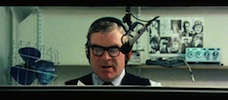
The Falls
1980 -
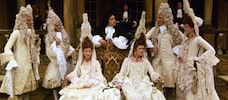
The Draughtsman’s Contract
1982 -

A Zed & Two Noughts
1985 -
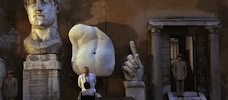
The Belly of an Architect
1987 -
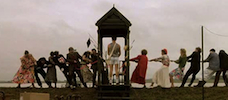
Drowning by Numbers
1988 -
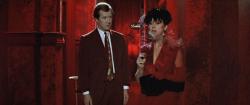
The Cook, the Thief, His Wife & Her Lover
1989 -

Prospero’s Books
1991 -

The Baby of Mâcon
1993
We don’t do comments anymore, but you may contact us here or find us on Twitter or Facebook.



